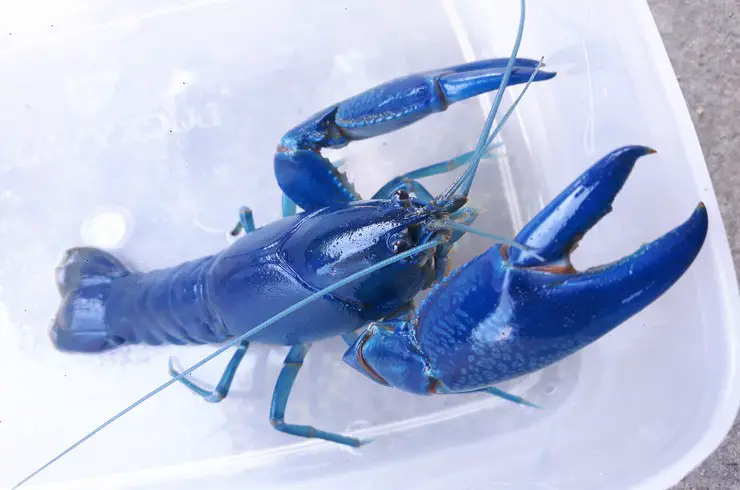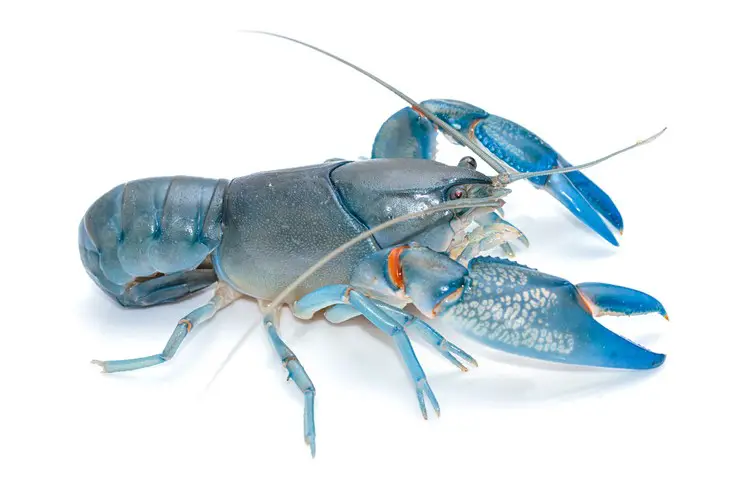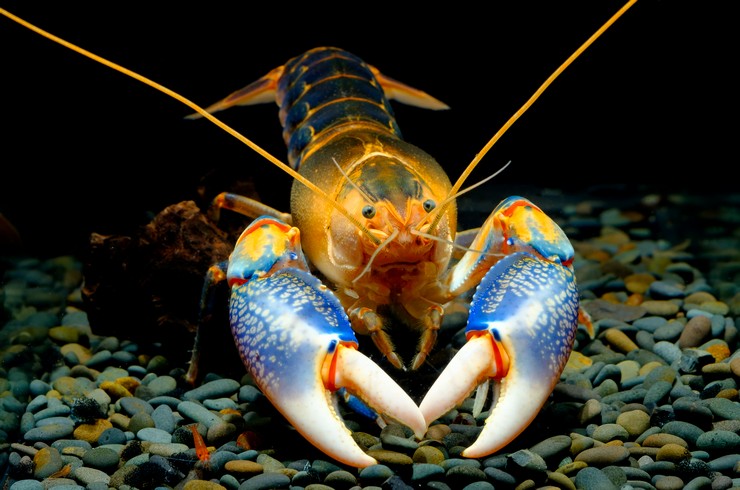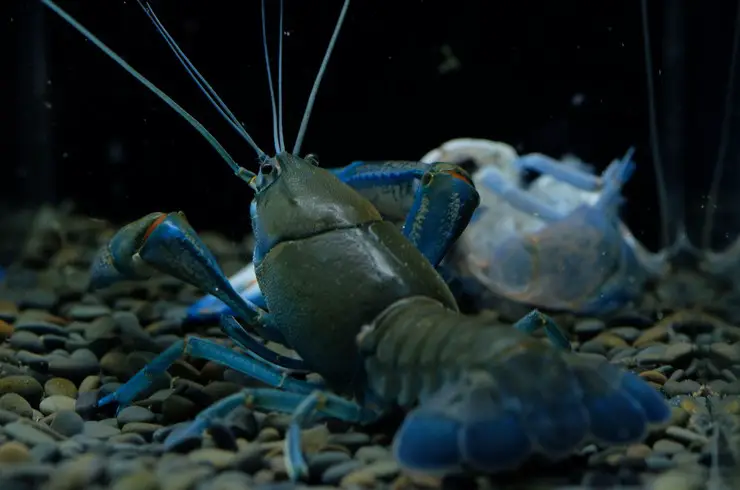The Australian CrayfishYabbi is often referred to as the “destroyer”. This may scare someone away from the desire to have such a creature because usually such names are given not by the calmest representatives of the animal world. However, Yabbi’s crayfish is a welcome exception. This destroyer, in fact, turns out to be a rather peaceful neighbor, who is able to turn only all the soil near his house. Read about how to contain this extraordinary beautiful crayfish in our article.
General information
Australian crayfish Yabbi, or Yabbi destroyer (Cherax destructor) – freshwater crustacean from the order of Decapod crayfish. Despite its rather impressive size (20-30 cm), it is one of the most popular aquarium crayfish. And it’s not just the lovely ultramarine color of the body. Crayfish Yabbi shows the beginnings of serious intelligence. He is well oriented in space with the help of developed eyes and sensitive antennas and is also able to recognize his congeners.
Hobbyists keeping these crustaceans report that their pets even show “emotions” such as curiosity or displeasure with the design change. The last crayfish are monitored extremely carefully: it does not matter how the aquarist arranges the decor elements, if Yabbi thinks that this shell or stone should not be here, then he will definitely move them. And even the name “destroyer” got its name for the ability to actively break the ground when arranging its territory. This behavior is not at all a whim of the animal. In its natural environment, this allows it to survive during droughts, buried in wet silt.
Crayfish Yabbi loves a secluded lifestyle. He spends most of his time in his burrow, showing himself when feeding or in the event that it is time to do “landscape design”.
At the same time, Yabbi’s crayfish is not at all aggressive, it never attacks small neighbors. But he will not let himself be offended, but raising his mighty claws will go on the attack. Although, if suddenly the enemy turns out to be larger and stronger, Yabbi’s crayfish, after assessing the situation with a powerful blow of its tail, lifts the silt from the bottom and quietly retreats while the enemy is disoriented.
Appearance
Like other representatives of the crustacean subtype, Yabbi’s body consists of two sections: the cephalothorax and abdomen. The first is covered with a dense chitinous shell, under the protection of which all internal organs are located. In the front are the senses – well-developed eyes, short antennae, and long antennae. At the bottom, walking legs are attached, the last pair of which has been modified into massive claws. They help the Yabbi crawfish dig, cut plants, or threaten unwanted guests. Also, with the help of pincers, the males hold the female during mating.

The abdomen is flexible, consists of articulated parts, below there are swimming legs – pleopods. The abdomen ends with a wide caudal fin of several plates.
The adult Australian crayfish Yabbi looks extremely impressive. The usual size of an individual is about 20 cm, but there are also 30-cm giants. The color of Yabbi the destroyer is quite variable and largely depends on where crayfish lives. But in the aquarium industry, individuals of various shades of blue are in the greatest demand.
Life expectancy in an aquarium is about 10 years.
Habitat
As the name suggests, Destroyer Yabbi’s Natural Habitat includes Southeast and South Australia. These are states such as Victoria and New South Wales. Crayfish are found mainly in small stagnant reservoirs and quiet backwaters.
Care and maintenance
You will need a large enough aquarium to keep Yabbi’s crayfish. Ideally, for a couple of individuals, it should be at least 100 liters. Since animals lead a near-bottom lifestyle, the bottom area should be maximized. It is advisable to cover the aquarium with a lid to prevent the escape of crayfish, but they do this only when they are kept in uncomfortable conditions.
Any soil will do but be prepared that it will be dug up with enviable regularity. It is important to create more variety of hiding places in the Yabbi Australian crayfish tank. Natural driftwood, grottoes, ceramic pots are well suited. It is also helpful to place dried oak or Indian almond leaves on the bottom.
To maintain high water quality, a filter of suitable power is installed in the aquarium, but the flow should not be too strong, because, in nature, crayfish prefer quieter places. Particular attention must be paid to aerating the aquarium. If Yabbi’s crawfish lacks oxygen, it may try to escape from the aquarium. High-quality aeration is especially important in the warm season when the water temperature rises because oxygen dissolves much worse in warm water. The most comfortable temperature for Yabbi’s crayfish will be 16-23 ° C. Of course, he will live at higher rates, but the increased water temperature will speed up the metabolism of crayfish, and, therefore, shorten the life span. The water should not be very soft, as crayfish need calcium and minerals to build their shells.
The Australian crayfish Yabbi is very sensitive to nitrogenous compounds, so it is important to change the water regularly. Once a week it is necessary to replace 20% of the old water with fresh water. If the water is taken from the mains, then it is recommended to prepare it with the Tetra Crusta AquaSafe conditioner, which instantly makes it safe for crayfish.
Optimum water parameters for the content: T = 16-23 ° C, pH = 7.0-7.5, GH> 10.
Crustaceans are characterized by regular shedding of the old chitinous cover, which is replaced by a new one. This process is called molting. Unfortunately, during this period, crayfish are most vulnerable, because the dense protective shell disappears, and any neighbor can harm Yabbi. Therefore, before molting, crayfish try to hide as diligently as possible so that no one disturbed them while the “clothes” are being changed. Young crayfish molt much more often than adults. Surprisingly, molting allows Yabbi crayfish to rebuild lost limbs. For a complete reconstruction, for example, a severed pincer usually requires 2-3 molts.
Compatibility
In relation to their relatives, the Australian crayfish Yabbi are not very friendly. Territory conflicts and lost limbs are inevitable. In one aquarium, only straight individuals should be kept – male and female, and each should have their own shelter.
Despite their large size and frightening appearance, Yabbi crayfish get along well with any peaceful fish: guppies, neons, thorns, ancistrus, etc. In gastronomic terms, crayfish are not at all interested in fish. Only occasionally can they scare neighbors with their large claws or try to grab the veil fin. Even the small shrimp cherries living at the bottom, Yabbi the destroyer is supportive. Perhaps only caviar will be in danger, the crayfish will eat it with pleasure.
You should not settle Yabbi’s crayfish with large predatory fish, they can regularly attack it, and if they manage to find it during the molting period, then crayfish will not have a chance.
But with plants, Yabbi crayfish are completely incompatible. Anything you try to plant in the ground will be mercilessly cut and eaten. Therefore, for such pets, only species floating on the surface are suitable.
Feeding Australian Crayfish Yabbi
The Australian crayfish Yabbi is a typical detritus feeder. It eats up any organic remains that fall to the bottom – parts of living plants, larvae, eggs, dead fish. Therefore, there should be no problems with feeding the pet. Various live food is often used – bloodworms, brine shrimp, etc., however, in order not to introduce parasites and provide crayfish with a nutritious diet, it is best to stay on high-quality dry food from the Tetra Crusta series. They provide crayfish with all the necessary nutrients, do not contribute to water pollution, and contain plant components and vitamins to maintain immunity.
Any sinking tablet for bottom fish works well, such as Tetra WaferMix or Tetra Pleco Spirulina Wafers. Dried Indian almond or oak leaves are well eaten by crayfish – the bacteria that multiply on their surface are very popular with crayfish.
Reproduction and breeding
It is quite easy to get offspring from the Australian Yabbi crayfish at home. If a pair of opposite gender individuals already lives in the aquarium, then the appearance of offspring is not far off.
It is not easy to tell the gender of Yabbi the Destroyer. Usually, they pay attention to the pincers (more powerful in the male) and the abdomen (wider in the female). Also, if you turn the male onto his back, then at the base of the last pair of walking legs you can find characteristic growths that resemble thorns.
After settling a male and a female in the same tank, be prepared for skirmishes at first. Thus, crayfish divide the territory. But when the carve-up is over, all conflicts will disappear into oblivion, and the male will sometimes even visit the female. When the crayfish are ready to mate, you can watch the mating dance: the male will play catch-up with the female until she finally surrenders and mating occurs.
After a few weeks, the female develops dark olive eggs. They hang on the pleopods, whose undulating movements deliver them a fresh portion of water. At this time, the newly-made mother usually sits in her shelter and only goes out to feed. However, this is sometimes not easy for her, because as soon as a vigilant male notices his passion not “at home”, he immediately sets off to drive her back with his claws.
Larvae soon emerge from the eggs, which at first hang on the abdominal legs, and a little later begin to explore a new world. However, at the first sign of danger, they return to their mother.
Young crustaceans begin their independent life after the first molt. They disperse around the aquarium, eat and grow vigorously, becoming twice as large after each molt. At this moment, it is necessary to carry out timely sorting of the offspring, since cannibalism is common in Yabbi crayfish. Although adult crayfish never offend offspring.

